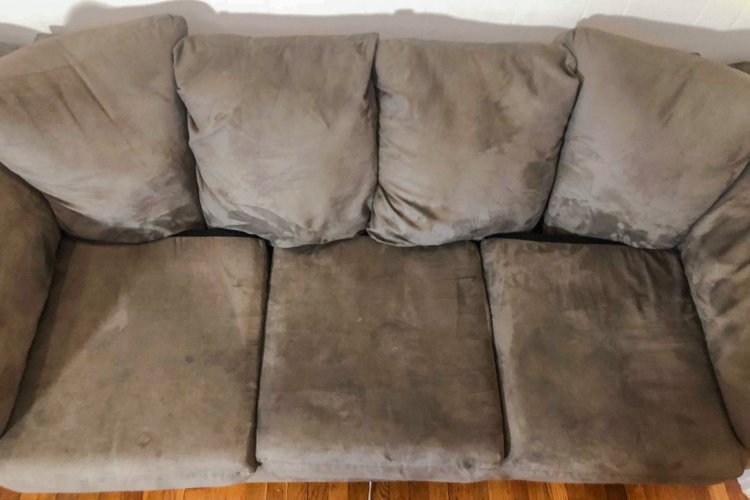How to Deal With Couch Stains

We like our home furniture and put all the effort to keep it in an attractive condition. For that, we regularly clean it and try to remove the stain over it. There is certain upholstery that catches stains very quickly. There are many home spills and home accidents which cause couch stains. Especially if you have a fabric sofa or couch then you should be very careful with the household spills.
Know All About Couch Stain
Manual stain treatment for fabric sofa and couches are not so easy. It is very difficult to deal with hard stubborn and old stains. You can see numerous types of stains on your couch. Prolong accumulated dirt and dust is the main reason for all the dirty stained couches. Apart from it, there are some other causes like outside dust and kitchen cooking oil and fat in the airflow, painting by kids and pet vomit and pees that make your favourite furniture ugly.
The best way to get rid of the stain is to hire professional care for your couch stain removal requirement. We strongly recommend you take the help of a professional couch stain removal service. They have all the knowledge of the variety of stains and their elimination process without being harsh to the couch fabric.
Every stain is different and the treatment process of all the stains is not the same. Few are easy to remove while the others are very hard and stubborn to deal with. Here we suggested some manual processes given by Upholstery Cleaning Adelaide experts to be followed to bring back the original look of your couch.
Furniture Cleaning & Stain Removal
Keep in mind that the specific approach may vary depending on the type of furniture material and the nature of the stain. Always refer to the manufacturer's instructions and perform a patch test in an inconspicuous area before applying any cleaning solution to the entire surface.
1. Dusting and Vacuuming:
- Start by removing loose dust and debris from the furniture using a soft brush or a vacuum cleaner with a brush attachment. This step is important to prevent scratching the surface during the cleaning process.
2. Fabric Upholstery:
- For general cleaning, check the care label on the furniture for any specific instructions. If there are no specific guidelines, you can often use a mild detergent mixed with water.
- Test the cleaning solution on a small, hidden area of the fabric to ensure it doesn't cause discolouration or damage.
- Gently blot the stained area with a clean cloth or sponge, working from the outside of the stain toward the centre. Avoid rubbing vigorously, as it can spread the stain or damage the fabric.
- If the stain persists, you may need to use a specialized upholstery cleaner or hire a professional.
3. Leather Upholstery:
- Remove dust and dirt from leather furniture regularly using a soft, dry cloth or a vacuum cleaner with a brush attachment.
- Wipe the leather surface with a damp cloth or sponge using a mild soap or a specialized leather cleaner recommended by the manufacturer.
- Avoid using excessive water, as it can damage leather. After cleaning, dry the surface with a clean, dry cloth.
- For specific stains like ink or grease, consult a professional leather cleaner.
4. Wood Furniture:
- For regular cleaning, use a soft, lint-free cloth or microfiber cloth to dust the surface of wood furniture. Avoid using abrasive materials that can scratch the finish.
- For removing stains on wood, you can try gently rubbing the affected area with a paste made from a mixture of baking soda and water or a mild wood cleaner.
- After cleaning, apply a furniture polish or wax to restore shine and protect the wood surface.
- If the stain is stubborn or the finish is damaged, it's advisable to seek professional help.
5. General Tips:
- - Clean spills and stains as soon as possible to prevent them from setting or becoming more difficult to remove.
- - Blot stains instead of rubbing, as rubbing can push the stain deeper into the material or damage the surface.
- - Always test any cleaning solution on a small, inconspicuous area before applying it to the entire surface.
- - Follow the manufacturer's instructions and recommendations for specific furniture materials and finishes.
Remember that these are general guidelines, and it's important to consider the specific material and stain when cleaning the furniture. If you have valuable or antique furniture, it's often best to consult a professional to ensure proper care and maintenance.
How Professional Couch Stain Removal Services Can Help You
A manual process of upholstery cleaning is not at all advisable. Go for a professional furniture cleaning service rather than doing it yourself.
- Eliminating the bad odour of your upholstery
- Keeping a perfect look of the home furniture
- Increase the life and usability of the couch
- Maintaining better home health and hygiene
It has been seen that your all manual care and diligence to keep the couch clean and stain free is important but along with that professional care is needed to remove old stubborn couch stains and germs from the upholstery permanently. They know the advanced technology to make it clean from the inside, and get top benefits of sofa cleaning at home. These germs and bacteria are the sole cause of all the ill health of your family and kids.

 drseervi
drseervi 














